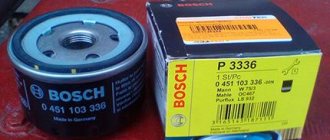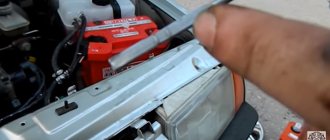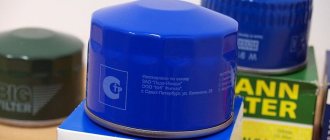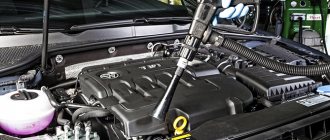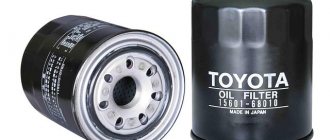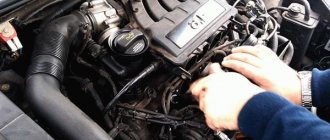If the engine oil is not changed for a long time, it can “kill” the engine. Therefore, it is worth discussing how to change engine oil, what the replacement interval is and why a new oil filter is installed.
Changing the engine oil of different brands of cars is not very different and follows the same pattern. First, select the appropriate oil based on the type and brand of engine. Next, warm up the engine to operating temperature. If it's warm, wait a few minutes to avoid getting burned. Then we find a suitable container where we will drain the waste liquid. An old canister will do if you cut off the side cap with a knife.
Next, unscrew the plug on the engine crankcase. This is usually the lowest point on the pallet, or check your owner's manual to be sure. We unscrew the plug with a wrench, and finally with our hands, because the oil will flow out immediately and quickly (place a container for draining in advance), otherwise you will lose the drain plug. The oil drains quickly, usually no more than five minutes. But it won’t be possible to drain it 100%. It's not scary, because... Usually no more than 2-3% of old fluid remains in the engine.
The old oil is drained, the color and the presence of foreign impurities are assessed.
These factors determine whether the engine requires flushing or replacement without flushing is necessary. Afterwards, a new one is poured in and the oil filter is changed. At this point the work is completed.
When pouring oil, constantly monitor the level using the oil dipstick - it should be between o and “max”. Fill in 80% of the total volume and then top up, adjusting with the dipstick.
Replacement interval
Should the manufacturer's recommendations be followed?
For modern engines, when the quality of oils improves, it is recommended to replace them after 10-15 thousand kilometers. This value is determined by the manufacturer under normal operating conditions. The worse the conditions, the earlier it needs to be changed. What is considered difficult conditions? These include: frosts, frequent changes in temperature, humid climate, and high dust levels in the air. Frequent engine overloads (for example, in mountainous areas or when transporting heavy loads) also do not contribute to maintaining performance. Typically, if driving conditions are determined to be severe, it is recommended to reduce the mileage before replacement by 25-30 percent.
Operating a car in the city is equivalent to heavy duty - a sluggish plug kills oil just as actively as off-road driving, mountain driving or motorsports. Average replacement time: 5,000 - 7,000 km for mineral water and 10,000 - 12,000 km for synthetic.
Do I need to change the oil filter?
Yes, definitely.
Working with a clogged engine filter is equivalent to working without it, because... the oil passes past the filter element. This is provided for by its design. With a mileage of 10,000 km, it will be clogged, which will lead to the opening of the bypass valve and the oil will go uncleaned. This results in intense engine wear. Although the emergency pressure light will not light up. If you change the filter yourself, do not forget to fill it with oil to about half the volume (for a better “first” start) and lubricate the rubber band on the filter housing.
1. Choose your engine oil carefully. Buy those that meet the tolerances and approvals of the auto concern. Remember, viscosity is not the most important parameter. The article “choosing engine oil” will help you with your choice.
2. Do not overuse “express” substitutions.
Vacuum replacement is bad because much more used oil remains in the engine than with traditional replacement using the drain method. Therefore, we alternate this method with the traditional one, while reducing the service interval or abandoning it altogether.
3. Change your oil more often! No air filter will capture all the dust and dirt that is present in the air. Accordingly, not a single fuel filter will retain impurities that are sold at gas stations along with fuel as a free bonus.
4. Do not use any additives
and additives in motor oil! Additives can be harmful; the positive effect of such impurities can be short-lived (what are the types of additives).
5. Monitor the oil level using the marks on the dipstick. Not filling up to the bottom mark can lead to oil starvation of the rubbing parts, which will lead to their rapid wear. Overfilling also negatively affects the performance of rubbing parts. What to do if the oil is filled above the level.
6. Do not buy oil from dubious sellers! Fake products will 100% not meet the manufacturer’s requirements, so the motor will quickly fail. Buy only original products at branded gas stations or find the nearest store that sells reliable products. Metal cans also serve as protection against counterfeiting.
Despite the obvious love of reading technical literature or owner's manuals, most of us people who truly love our cars understand that the oil filter should be replaced at least once a year.
This is exactly the case when the butter cannot be spoiled by porridge. Even two of the cheapest and simplest working filters are better than one expensive one designed for a long period of operation.
Without hesitation, you should change the oil filter twice a year or after 7 thousand mileage if:
- you have to travel a lot in hot and dusty conditions;
- you have to work by car for many hours on city streets, in traffic congested by public transport;
- The car was just purchased and has not been driven in.
The second, no less important condition is the correct choice of manufacturer and filter model. Before changing the oil filter, find out which one is used in your car and the fitting size of the threaded fitting. This way you will avoid an unpleasant situation when the purchased new element does not fit on the mounting flange and fitting of the engine.
Replacement in a system with a replaceable filter element
The more the car works, the more often the oil filter has to be changed to avoid oil degeneration and premature wear of components. Therefore, a design with a replaceable filter element is used in light trucks, conveyors, and heavy road equipment. Sometimes found on passenger cars of outdated design.
Replacing the element is quite simple. With rare exceptions, the device body itself is accessible from any position. Using a 19mm wrench, unscrew the cover securing nut, replace the filter cartridge, thin ring gasket and, in some cases, a copper washer - the gasket under the main nut. The entire replacement procedure takes a few minutes and requires care and precision.
Is it possible not to change some car filters?
During scheduled maintenance, technicians first advise changing all the filters in the car. This, in principle, complies with the manufacturers' regulations, but does not mean that you have to agree with it. Some filters do not need to be changed so often, but rather cleaned. Auto mechanics will help you with this. But this procedure is not suitable for all filters. To find out which ones, read on.
You definitely don't need to change the air filter that often. In winter, it is practically not polluted. And in the summer you can clean it yourself - using a cloth, a vacuum cleaner or a compressor. The main thing is to do this often so that it does not have time to become completely unusable. This way, its service life will increase significantly, and you will save money.
Still, you should listen to the recommendations of the manufacturers and not be too self-willed, because they will not give bad advice - only what will help the car function properly for as long as possible. And cleaning the air filter yourself can be useful as a last resort in an emergency.
The same recommendation applies to cleaning the cabin filter, because they also should not be changed too often. The manufacturer recommends doing this every 10-15 thousand km, in reality - not so often, you don’t need to worry earlier than after 20-30 thousand km. Again, we focus on our experience and take a closer look at the environment in which the car has to operate. After the peat bogs burned in Moscow (everyone remembers that smog), absolutely all car owners were required to replace cabin filters, regardless of how often they were used to doing it. This is because even after a couple of thousand kilometers, the parts became shamelessly clogged with fumes, and it leaked into the cabin, threatening people’s health. Therefore, everything is individual and all factors must be taken into account. In any case, timely cleaning of the cabin filter will help you save money on replacing it and protect you from malfunctions.
But it is worth noting that the service life of cabin filters is quite long, and even without cleaning they work properly for about a year. Most likely, after such a marathon, cleaning will no longer help, and you will have to change it.
But fuel filters cannot be cleaned - only changed. The good news is that you don’t have to do this so often. Oil ones too, but they have to be changed quite often - every 10-15 thousand km, depending on the manufacturer’s recommendations, along with the engine oil.
The car requires attention and care to maintain its performance. Frequently changing consumables and parts is the best way to achieve this. Follow the advice of manufacturers and experienced car owners, and your car will last you longer.
This is interesting: How often do you need to change the oil in a Subaru gearbox?
Replacing a disposable full-flow oil filter
Thanks to its simple design, replacing a one-piece oil filter requires less effort and preparation work.
Often, especially during the first engine oil changes after break-in, the problem arises of how to unscrew the oil filter. It is round in shape, without special platforms or grooves that could be used for tools. A typical disposable oil filter is designed to use hand force. But it is not always enough to unscrew and tear off the burnt rubber gasket. In this case, you can use the following as a replacement:
- standard "crab" type device;
- self-tightening band or chain wrench;
- a couple of through holes, carefully punched with a sharp screwdriver slightly to the side of the body axis. Before removing the oil filter without a key, wait until the oil drains from the inside of the housing.
Important! The last option is used as a last resort due to the risk of damaging the fitting.
Functions and principle of operation of the cabin filter
It is designed to purify the air that enters the car interior. The filter is assembled from a housing and activated carbon located in it, through which the air flow passes, and foreign particles remain in it. As various debris accumulates, it loses its functions and needs to be replaced.
You also need to remember that this filter protects the air conditioner evaporator from clogging. It is recommended to replace the filter simultaneously with updating the oil. But if the windows fog up in humid weather, then this is the main sign that this filter needs to be replaced.[/stextbox
When replacement is necessary
In a hurry or when parked at work, little attention is paid to properly working machine parts. There are no sensors or visual indicators in the oil filter that make it possible to clearly and promptly not miss the moment when the filter element becomes clogged and loses its ability to pass oil flow through its pores.
Advice! For a timely response, it is necessary to know the capabilities of the oil, filter and the condition of the cylinder-piston group of the machine.
Sometimes poor performance of the filter element is caused by a change in the color of the engine oil. Even good flushing materials do not remove all hydrocarbon decomposition products, varnish and bitumen films, soot and amorphous carbon from the circulation system and oil channels. Therefore, a new good quality lubricant will dissolve and wash away some of the deposits and will certainly darken to the color of bad coffee.
During operation, the new filter element will slightly brighten the quality of the oil. From this moment on, the lubricant will begin to confidently accumulate dirt and waste products in its composition. After a run of approximately 40% of the calculated life of the oil filter, the main, smallest pores of the filter element will be clogged, but the ability to adsorb thick and dense lumps of sludge will remain. For an engine with a high degree of wear, the oil filter can still serve effectively. For relatively “fresh” engines, it is better to replace the filter element with a new one.
For mineral oils, the old method of contaminants is often used. To do this, use a dipstick (level indicator) to transfer a few drops of oil onto clean newsprint. If the lubricant stain is evenly colored, the oil is still suitable for use. If a darker or even black central blot stands out against the background of the light outskirts of the spot, the filter element should be urgently replaced.
If there is oil leakage from under the edge of the housing adjacent to the mounting flange, it is better to replace the filter with a new one, having first checked the condition of the lubricant in the engine sump.
For older engines, replacing the filter is important, but not so critical. For relatively new or heavily loaded engines, the oil filter should be replaced even more often than once every six months.
Advice! Before installation, be sure to pour a small amount of oil into the housing and lubricate the rubber seal ring.
How to replace a filter in an automatic transmission
While cleaning the transmission fluid from foreign particles, the filter becomes clogged over time and ceases to perform its functions. The procedure for replacing the filter element coincides with the procedure for replacing the lubricant in an automatic transmission.
Please note that each manufacturer has different timings for replacing transmission fluid, depending on the specific technical characteristics of a particular unit. At the same time, in practice, there are also cases when, for various technical reasons, the filter will require replacement more often than the planned service interval for a complete replacement of the lubricant in the automatic transmission.
As mentioned above, filters in automatic transmissions may have different filter materials, which affect their service life. This means that replacing the filter in an automatic transmission must be carried out taking into account the characteristics of such material. As a rule, in old automatic boxes they use a metal mesh as a filter material.
Such filters are distinguished by their durability and are changed after at least one oil change. If the liquid in the box is not dirty, just remove the metal mesh and rinse well. However, such a filter has a drawback, since, while catching dirt and chips of large and medium sizes, it allows small chips to pass through. For this reason, in automatic transmissions with a strainer, the fluid is changed more often.
Replacing the oil filter without changing the oil
The simplicity of the oil change procedure is a little blurred by the need to tinker with possible lubricant leaks from the crankcase and oil channels. Typically, the design of the engine provides that the oil filter is higher than the oil level in the sump, so by unscrewing the housing of the part, you most likely will not get a waterfall of lubrication. A small amount of material remaining in the channels and held by the filter valve will come out through the working holes.
Important! If your car has a rear that is too raised as a result of modifications or tuning, you should carefully read the following recommendations.
If the engine position in the car is not horizontal, additional measures must be taken before replacing the oil filter. It is enough to drain the engine oil so that its level is one third lower than the standard value. In this case, after removing the old housing, there will be no oil leakage from the lubrication system through the working holes.
In some cases, it is recommended that when placing the car on the inspection hole, place a small rise of a pair of boards under the front wheels so that the front of the car becomes ten centimeters higher than the rear part. In this case, all the engine oil remaining in the lubrication system will flow away in the direction opposite to the oil pump. In this way, you can replace the oil filter without changing the oil, without fear of losing precious fluid. Before installation, they usually try to fill the housing with oil to reduce lubricant pressure losses in the system. But, if you use good quality synthetics or semi-synthetics, you don’t have to worry about oil starvation - the housing will fill very quickly, within 1-2 seconds.
Advice! Before replacing the oil filter, take care to add a small amount of lubricant to the engine and compensate for the loss of oil remaining in the body of the old unit.
The video shows how to change the oil and oil filter on a LADA Kalina:
The need to replace the oil filter without changing the oil can arise for many reasons, the main one being inattention. For example, after adding lubricant, a car enthusiast remembers that the oil filter also needed to be changed. Is it possible to get out of this situation with the least losses, let's figure it out.
Removing the old filter device
The need to change the oil filter without changing the oil arises in the following situations:
- The new oil filter turned out to be defective, and there were noticeable irregularities in the operation of the filter element. It is especially unpleasant when problems are discovered after installing a new filtration product on a car. In this case, there is a lubricant inside the engine that can be used for some time, but the filter must be changed.
- The moment to replace the engine fluid has already arrived, but it was not possible to get the necessary oil filter. For example, a filter has been ordered, but delivery is late (it is not possible to supply a duplicate product). After delivery of the new filter device, it will be necessary to install it on the machine, but there is no need to change the oil.
- Inattention. When changing the engine mixture, the mechanic forgot to replace the filter device.
The main problem that arises when replacing the oil filter without changing the engine mixture is the possibility of a large amount of oil leaking out of the engine. Many car enthusiasts believe that when performing the above procedure, they will have to purchase a large volume of lubricant. This is a mistaken opinion; if the replacement procedure is done correctly, then you can get by with minimal losses of motor oil.
Oil filter operating mechanism
It controls the volume of lubricant supplied to the engine, while simultaneously cleaning the incoming substance from all existing coarse impurities. The filter housing contains high-strength porous paper. The surface of the paper is treated with a special waterproof resin.
It must be replaced simultaneously with the replacement of the lubricant. Basically, such a replacement is carried out after 12-15 thousand km. mileage This figure is an average, and the exact replacement parameters should be obtained from the car’s developers and manufacturers. The simple design provoked such a situation in the automotive spare parts market that many companies began to produce this filter element.
But for the correct purchase and reliable and long-term operation, you need to buy the original product and exclusively by the catalog number. This is the only way to avoid purchasing a fake and causing subsequent problems with the operation of the car. Installing a poor quality one can lead to rupture of the filter material or housing, which will cause lubricant to leak from the engine.
Good to know: What happens if you pour oil into the engine?
Replacement procedure
Installing a new oil filter
Replacing the oil filter without changing the oil should not involve large losses of the engine mixture. Car oil flows under the influence of gravity into the engine crankcase. The crankcase is located below the installation site of the filtration barrier. Therefore, losses of the lubricant mixture are possible in an amount equal to the volume of liquid in the oil filter itself. This is about about a glass.
The procedure for changing the oil filter without draining the engine mixture consists of the following steps:
- Perform the dismantling procedure on a cold engine. Otherwise, you can get burns on your hands from hot engine fluid. If before carrying out work to replace the filtration element, the car was driven and the engine became hot, then let the power unit cool down, this will take about 40 minutes.
- To prevent the oil leaking from its housing from staining the engine and other elements of the car when changing the filter device, place a small container to drain the liquid from the filter.
- Do not unscrew the plug on the valve cover: if the plug is open, more lubricant will leak out.
- Unscrew the filtration element, do this procedure gradually. Auto repairmen recommend unscrewing the filter halfway, then carefully draining the oil; after such manipulations, it is permissible to remove the filter element completely.
- Apply a few drops of motor fluid similar to that inside the engine onto the rubber to seal it.
- Install the new filter device into place.
- Check the engine fluid level and, if necessary, add lubricant to the required level.
When changing the oil filter using the method described above, you may lose a glass of lubricant. Very careful car enthusiasts recommend pouring the engine mixture drained from the filter element back into the engine. We strongly do not recommend pouring drained fluid into the car engine - this saving can be disastrous. Because when draining the specified liquid from the oil filter, it will not be possible to prevent dust particles and other contaminants from entering it. Plus, you won’t be able to save too much money on refills.
Change of oil. Useful tips and tricks - DRIVE2
A few tips and recommendations for changing the oil, if you adhere to them constantly, you will extend the life of your engine and save a fairly decent amount of money on future repairs. We’ll also tell you how to change the engine oil yourself and whether you need to change the oil filter at every oil change.
How to change engine oil?
Changing the engine oil of different brands of cars is not very different and follows approximately the same pattern. If you are going to do all the work yourself, then first we select a motor oil that is suitable for the type and brand of engine, the old oil is drained, its color and the presence of foreign impurities are assessed. Impurities in the oil can be organic (carbon deposits) and inorganic (road dust) in nature. These factors determine whether an engine flush is required or whether an oil change without flushing is necessary. After new oil is added, the oil filter is usually changed, after which the engine oil change is considered complete.
Do I need to change the oil filter when changing the oil?
Yes, when changing the engine oil, you must also replace the oil filter. If you change the oil at a car service center, then the oil change service also includes replacing the oil filter.
So why change the oil filter?
Operating an engine with a clogged oil filter is equivalent to operating an engine without a filter. Since the oil bypasses the filter element. This is provided for by the design of the oil filter. Whenever you change the oil, it is necessary to change the filter, because during normal operation it will already be clogged by 8,000 km, which will lead to the opening of the bypass valve and the oil will go to the rubbing vapors unpurified. This results in intense engine wear. Although the emergency pressure light will not light up.
Tips for changing engine oil
1. Change your oil more often! No air filter will capture all the dust and dirt that is present in the air. And, accordingly, not a single fuel filter will retain those impurities that are sold at our gas stations along with fuel as a free bonus.
2. Do not abuse “express” oil changes. The disadvantage of vacuum oil changes is that much more used motor oil remains in the engine than with a traditional oil change using the drain method. Therefore, this method of changing the oil must be alternated with traditional draining, thereby reducing the service interval.
3. Choose your engine oil carefully. Buy only those motor oils that meet the tolerances and approvals of the vehicle manufacturer. Remember that viscosity is not the most important parameter.
4. Under no circumstances use any additives or additives in motor oil! Oil additives can only cause harm; the positive effect of such impurities can be very short-lived.
5. Do not buy motor oils from dubious sellers! A 100% counterfeit motor oil will not meet the requirements of the car manufacturer, so the engine can quickly fail.
6. Don't skimp on filters! Remember that every speck of dust and particle passed by one filter or another into the engine becomes an excellent abrasive material that destroys the gaps and internal surfaces of your engine.
7. Check the chassis every time! The car still goes to the service station and goes up on a lift. For a very modest surcharge you will gain confidence in your car. Failure of an electrical or even power unit on the road will simply result in a tow truck, but surprises from the chassis can lead to irreparable consequences.
Thanks to everyone who read! Good luck on the roads and take care of your iron horses!
www.drive2.ru
Replacement frequency
The frequency with which the filter device must be replaced is directly determined by its manufacturer. The standard period is every 8 - 12 thousand km. If you have any doubts about the effectiveness of the oil filter, more frequent replacement is acceptable.
The cost of the filter is much lower than the cost of a new engine, so it is better to play it safe and follow these recommendations:
- using a filter that does not match the make of your car is prohibited, otherwise important functional components of the power unit may fail;
- Since each car has its own characteristics, you should choose a filter device taking into account the certain amount of pressure for which it is designed.
Fuel filter characteristics
It is used to clean the fuel entering the power unit. The purity of the fuel used directly depends on the duration of normal operation. There are two types of fuel filters installed in cars: in-line and submersible.
They must be replaced according to the recommendations of the car manufacturer or the first signs of failure. If you do not change it, this can lead to the following consequences:
- clogging and subsequent decrease in the efficiency of the fuel system;
- breakdown of injectors;
- reduction in engine power;
- unstable operation of the unit as a whole.
Instructions for replacing the oil filter
First, determine where the oil filter is located. Its location depends on the engine design and manufacturer. There are both upper and lower locations, but often this is the front area of the engine of its lower part in the case of front-wheel drive cars.
Side left or right side placement is common with rear wheel drive vehicles. Placing the filter directly under the hood contributes to its comfortable maintenance to the greatest extent.
Before you begin the replacement, you need to prepare the necessary consumables and tools. First of all, you will have to buy new oil and filter; be sure to follow the relevant requirements of the manufacturer of your car.
Flushing
Reusing an oil filter is possible - it depends on the filter component and its reaction to oil, gasoline or kerosene. First, plugs and plugs are used to close the clean part of the assembly to prevent additional contamination of the cavity. Rinse it well. This is followed by drying and ultrasonic purging. More often than not, replacing an old copy with a new one is more profitable in terms of money and time spent.
Classification of MF by flow type:
- full;
- partial;
- combined.
Full-threaded.
The main flow of the substance undergoes purification. The result is that well-refined oil is supplied to the engine. The basis of the design here is a bypass valve that controls the pressure in the internal combustion engine.
Partial flow.
Here the cleaning takes longer, but the quality is better. The oil circulates in two cycles: from the pump to the rubbing elements - one, through the cavity of the cleaner - the second.
Combined.
The two previous methods are combined, which leads to more thorough cleaning of the oil.
Is it possible to replace the filter without draining the oil?
This question is often alarming and confuses many car enthusiasts, because they are afraid of spilling all the oil on the ground through the mounting hole on the engine block.
There is data on this matter obtained from the experience of many drivers. Firstly, theoretically, when the cold engine is not running, the oil flows into the crankcase, which is located below the filter level. Secondly, oil is pumped there only when the oil pump is running. Based on all this, it is logical to assume that the lubricant can splash out only in a small amount, which corresponds to the volume of the filter element itself.
Still, in order to avoid unpleasant situations, it is important to follow certain rules.
- Such manipulations should only be carried out on a cold engine. It is important that the car sits for at least an hour. Otherwise, hot oil may splash out from under the filter and scald your hands;
- In the work area, place a small container underneath to collect the leaking liquid;
- The element should be unscrewed slowly. First, halfway, expressing the liquid lubricant, and only then remove it completely;
- The plug on the valve cover must not be unscrewed;
- On the new filter element, you need to coat the rubber seal with oil;
- The new filter is screwed into place;
- After completing the procedure, it is advisable to check the oil level using a dipstick and top up if necessary.
Replacing the oil filter without changing the oil should be done in rare cases when it is impossible to do without it. It is best to replace consumables comprehensively, while washing the motor using special washes. You can easily find everything you need in
Purpose and mechanism of operation of the air filter
It functions to purify atmospheric air coming from the environment, which enters the power unit through air ducts. This element itself is made of porous and thick paper fixed in a plastic case. It needs to be replaced at the same time as the oil change, but if the car travels most of its mileage on dusty dirt roads, then it should be replaced earlier. You can replace the filter yourself, since it is located in a fairly accessible place and even a novice motorist can do this work.
Some motorists do not replace it with a new one, but try to clean it with a vacuum cleaner or other devices. This is not entirely correct, and given the fairly low price, it is still preferable to install a new one.
